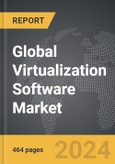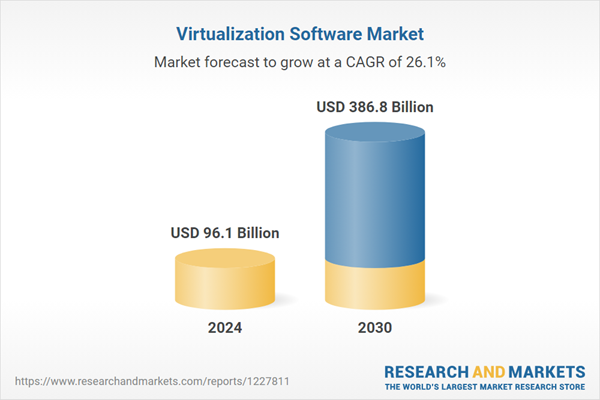Global Virtualization Software Market - Key Trends & Drivers Summarized
Virtualization software has become a cornerstone of modern IT infrastructure, enabling organizations to maximize the efficiency and flexibility of their hardware resources. By creating virtual instances of physical hardware, virtualization software allows multiple operating systems and applications to run on a single physical machine. This technology abstracts the physical hardware, providing a layer of software that manages the resources and allocates them to various virtual machines (VMs). Major players in this space include VMware with its vSphere suite, Microsoft with Hyper-V, and open-source solutions like KVM. These platforms provide the tools necessary to create, manage, and optimize virtual environments, offering capabilities such as live migration, dynamic resource allocation, and automated management.The benefits of virtualization software are profound, driving its adoption across industries. One of the primary advantages is server consolidation, which reduces the number of physical servers needed, thereby cutting costs associated with hardware, energy consumption, and physical space. Virtualization also enhances disaster recovery solutions; virtual machines can be easily backed up, replicated, and restored, ensuring business continuity in the event of a hardware failure. Additionally, virtualization simplifies the management of IT resources by centralizing control and providing comprehensive monitoring and automation tools. This level of control helps IT departments respond quickly to changing business requirements, deploy applications faster, and improve overall system reliability and performance. Virtualization is also a key enabler of cloud computing, providing the underlying technology for creating scalable, flexible cloud environments.
The growth in the virtualization software market is driven by several factors. Technological advancements, such as the integration of artificial intelligence (AI) and machine learning (ML) for automated resource management and predictive maintenance, have significantly enhanced the capabilities of virtualization platforms. The increasing shift towards cloud computing has fueled demand for virtualization, as it is essential for managing and scaling cloud infrastructures. Businesses are also under constant pressure to reduce IT costs and increase operational efficiency, which virtualization directly addresses by optimizing resource utilization and minimizing hardware expenditures. The rise of digital transformation initiatives, which require agile and scalable IT environments, further accelerates the adoption of virtualization software. Additionally, the growing need for robust cybersecurity measures and data protection solutions has spurred interest in virtualization's ability to isolate workloads and secure sensitive information. The proliferation of remote work and the need for resilient IT systems that can support distributed workforces have also highlighted the importance of virtualization in ensuring business continuity and flexibility. These factors collectively drive the expanding market for virtualization software, as organizations seek to leverage advanced technologies to stay competitive and meet evolving business demands.
Report Scope
The report analyzes the Virtualization Software market, presented in terms of market value (USD). The analysis covers the key segments and geographic regions outlined below.- Segments: Technology (Network Function Virtualization, Desktop Virtualization, Software-defined Storage, Server Virtualization).
- Geographic Regions/Countries: World; USA; Canada; Japan; China; Europe; France; Germany; Italy; UK; Spain; Russia; Rest of Europe; Asia-Pacific; Australia; India; South Korea; Rest of Asia-Pacific; Latin America; Argentina; Brazil; Mexico; Rest of Latin America; Middle East; Iran; Israel; Saudi Arabia; UAE; Rest of Middle East; Africa.
Key Insights:
- Market Growth: Understand the significant growth trajectory of the Network Function Virtualization segment, which is expected to reach US$164.5 Billion by 2030 with a CAGR of 28.1%. The Desktop Virtualization segment is also set to grow at 24.1% CAGR over the analysis period.
- Regional Analysis: Gain insights into the U.S. market, valued at $35.9 Billion in 2024, and China, forecasted to grow at an impressive 27.5% CAGR to reach $44.7 Billion by 2030. Discover growth trends in other key regions, including Japan, Canada, Germany, and the Asia-Pacific.
Why You Should Buy This Report:
- Detailed Market Analysis: Access a thorough analysis of the Global Virtualization Software Market, covering all major geographic regions and market segments.
- Competitive Insights: Get an overview of the competitive landscape, including the market presence of major players across different geographies.
- Future Trends and Drivers: Understand the key trends and drivers shaping the future of the Global Virtualization Software Market.
- Actionable Insights: Benefit from actionable insights that can help you identify new revenue opportunities and make strategic business decisions.
Key Questions Answered:
- How is the Global Virtualization Software Market expected to evolve by 2030?
- What are the main drivers and restraints affecting the market?
- Which market segments will grow the most over the forecast period?
- How will market shares for different regions and segments change by 2030?
- Who are the leading players in the market, and what are their prospects?
Report Features:
- Comprehensive Market Data: Independent analysis of annual sales and market forecasts in US$ Million from 2024 to 2030.
- In-Depth Regional Analysis: Detailed insights into key markets, including the U.S., China, Japan, Canada, Europe, Asia-Pacific, Latin America, Middle East, and Africa.
- Company Profiles: Coverage of players such as Microsoft Corporation, Huawei Technologies Co., Ltd., Google LLC, Citrix Systems, Inc., Vmware, Inc. and more.
- Complimentary Updates: Receive free report updates for one year to keep you informed of the latest market developments.
Some of the 105 companies featured in this Virtualization Software market report include:
- Microsoft Corporation
- Huawei Technologies Co., Ltd.
- Google LLC
- Citrix Systems, Inc.
- Vmware, Inc.
- Amazon Web Services, Inc.
- Red Hat, Inc.
- Corel Corporation
- Nimboxx, Inc.
- Dali Wireless, Inc.
This edition integrates the latest global trade and economic shifts into comprehensive market analysis. Key updates include:
- Tariff and Trade Impact: Insights into global tariff negotiations across 180+ countries, with analysis of supply chain turbulence, sourcing disruptions, and geographic realignment. Special focus on 2025 as a pivotal year for trade tensions, including updated perspectives on the Trump-era tariffs.
- Adjusted Forecasts and Analytics: Revised global and regional market forecasts through 2030, incorporating tariff effects, economic uncertainty, and structural changes in globalization. Includes historical analysis from 2015 to 2023.
- Strategic Market Dynamics: Evaluation of revised market prospects, regional outlooks, and key economic indicators such as population and urbanization trends.
- Innovation & Technology Trends: Latest developments in product and process innovation, emerging technologies, and key industry drivers shaping the competitive landscape.
- Competitive Intelligence: Updated global market share estimates for 2025, competitive positioning of major players (Strong/Active/Niche/Trivial), and refined focus on leading global brands and core players.
- Expert Insight & Commentary: Strategic analysis from economists, trade experts, and domain specialists to contextualize market shifts and identify emerging opportunities.
Table of Contents
Companies Mentioned (Partial List)
A selection of companies mentioned in this report includes, but is not limited to:
- Microsoft Corporation
- Huawei Technologies Co., Ltd.
- Google LLC
- Citrix Systems, Inc.
- Vmware, Inc.
- Amazon Web Services, Inc.
- Red Hat, Inc.
- Corel Corporation
- Nimboxx, Inc.
- Dali Wireless, Inc.
Table Information
| Report Attribute | Details |
|---|---|
| No. of Pages | 464 |
| Published | December 2025 |
| Forecast Period | 2024 - 2030 |
| Estimated Market Value ( USD | $ 96.1 Billion |
| Forecasted Market Value ( USD | $ 386.8 Billion |
| Compound Annual Growth Rate | 26.1% |
| Regions Covered | Global |









